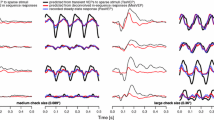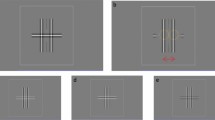Abstract
We investigated the effect of reduced luminance and increased scatter on the pattern visual evoked potential and eye-hand reaction time evoked to a check size of 0.5° in 10 normal subjects. Data analysis indicated that a reduction in luminance as well as an increase in scatter caused a statistically significant increase in the peak time of the pattern visual evoked potential P100 wave. The reaction time, however, was not significantly affected by the initial 0.9-log unit attenuation of the stimulus luminance or the 0.3 scatter filter. Further attenuation of luminance or increase of scatter also yielded statistically significant increases. Our results suggest that the reaction time is less affected by a reduction in luminance or an increase in scatter of a 0.5° stimulus than the pattern visual evoked potential is and therefore represents a more reliable test to assess visual function, especially in the presence of medial opacities, which are known to reduce luminance and produce scatter.
Similar content being viewed by others
References
van der Tweel LH, Estevez O, Cavonius Cr. Invariance of the contrast evoked potential with changes in retinal illuminance [Letter]. Vision Res 1979; 19: 1283–7.
Vaughan HG Jr, Costa LD, Gilden L. The functional relation of visual evoked response and reaction time to stimulus intensity. Vision Res 1966; 6: 645–56.
Hirose T, Wolf E, Malin S. Human visual evoked responses to focal illumination of the retina. Clinical applications. In: Pruett RC, Regan CD, eds. Retina Congress, 25th Anniversary Meeting of the Retina Service, Massachussets Eye and Ear Infirmary. New York: Appleton-Century-Crofts, 1972: 55–78.
Halliday AM, McDonald WI, Mushin J. Delayed pattern evoked responses in optic neuritis in relation to visual acuity. Trans Ophthalmol Soc UK 1973; 93: 315–24.
Cant BR, Hume Al, Shaw NA. Effects of luminance on the pattern visual evoked potential in multiple sclerosis. Electroencephalogr Clin Neurophysiol 1978; 45: 496–504.
Sokol S. Pattern visual evoked potentials. Their use in pediatric opthalmology. In: Sokol S, ed. Electrophysiology and psychophysics. Their use in ophthalmic diagnosis. Boston: Little Brown, 1980: 251–68.
Froehlich J, Kaufman DI. Effect of decreased retinal illumination on simultaneously recorded pattern electroretinograms and visual evoked potentials. Invest Ophthalmol Vis Sci1991; 32: 310–8.
Rains JD. Signal luminance and position effects in human reaction time. Vision Res 1963; 3: 239–51.
Chelva E, Van Lith GHM. Influence of defocusing, absorption and scatter on evoked potentials to contrast and contour related stimuli. Doc Ophthalmol Proc Ser 1982; 31: 337–44.
Bobak P, Bodis-Wollner I, Guillory S. The effect of blur and contrast on VEP latency. Comparison between check and sinusoidal grating patterns. Electroencephalogr Clin Neurophysiol 1987; 68: 247–55.
Sokol S, Moskowitz A. Effect of retinal blur on the peak latency of the pattern evoked potential. Vision Res 1981; 21: 1279–86.
Collins DWK, Carroll WM, Black JL. Effect of refractive error on the visual evoked response. Br Med J 1979; 1: 231–2.
Brigell MG, Goodwin JA, Lorance R. Saccadic latency as a measure of afferent visual conduction. Invest Ophthalmol Vis Sci 1988; 29: 1331–8.
Author information
Authors and Affiliations
Rights and permissions
About this article
Cite this article
Mckerral, M., Lachapelle, P. & Benoit, J. Comparative effects of luminance and scatter on the pattern visual evoked potential and eye-hand reaction time. Doc Ophthalmol 79, 177–185 (1992). https://doi.org/10.1007/BF00156576
Accepted:
Issue Date:
DOI: https://doi.org/10.1007/BF00156576




